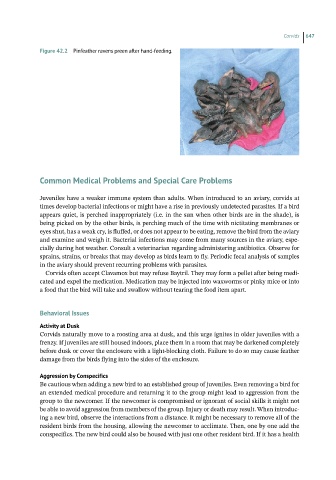Page 646 - Hand rearing birds second
P. 646
Corvids 647
Figure 42.2 Pinfeather ravens preen after hand-feeding.
CommonMedicalProblemsand SpecialCareProblems
Juveniles have a weaker immune system than adults. When introduced to an aviary, corvids at
times develop bacterial infections or might have a rise in previously undetected parasites. If a bird
appears quiet, is perched inappropriately (i.e. in the sun when other birds are in the shade), is
being picked on by the other birds, is perching much of the time with nictitating membranes or
eyes shut, has a weak cry, is fluffed, or does not appear to be eating, remove the bird from the aviary
and examine and weigh it. Bacterial infections may come from many sources in the aviary, espe-
cially during hot weather. Consult a veterinarian regarding administering antibiotics. Observe for
sprains, strains, or breaks that may develop as birds learn to fly. Periodic fecal analysis of samples
in the aviary should prevent recurring problems with parasites.
Corvids often accept Clavamox but may refuse Baytril. They may form a pellet after being medi-
cated and expel the medication. Medication may be injected into waxworms or pinky mice or into
a food that the bird will take and swallow without tearing the food item apart.
Behavioral Issues
Activity at Dusk
Corvids naturally move to a roosting area at dusk, and this urge ignites in older juveniles with a
frenzy. If juveniles are still housed indoors, place them in a room that may be darkened completely
before dusk or cover the enclosure with a light-blocking cloth. Failure to do so may cause feather
damage from the birds flying into the sides of the enclosure.
AggressionbyConspecifics
Be cautious when adding a new bird to an established group of juveniles. Even removing a bird for
an extended medical procedure and returning it to the group might lead to aggression from the
group to the newcomer. If the newcomer is compromised or ignorant of social skills it might not
be able to avoid aggression from members of the group. Injury or death may result. When introduc-
ing a new bird, observe the interactions from a distance. It might be necessary to remove all of the
resident birds from the housing, allowing the newcomer to acclimate. Then, one by one add the
conspecifics. The new bird could also be housed with just one other resident bird. If it has a health

